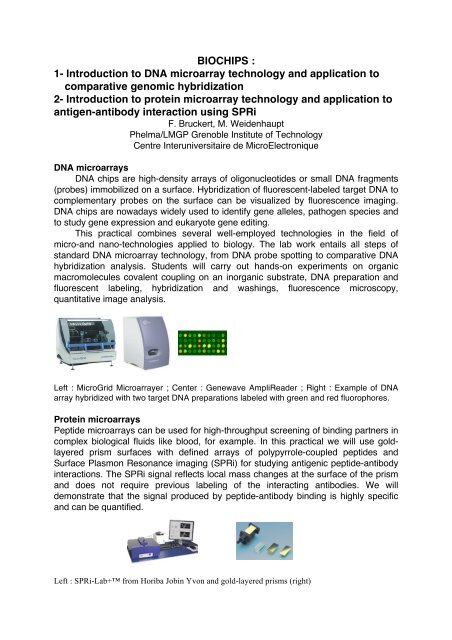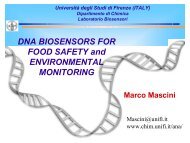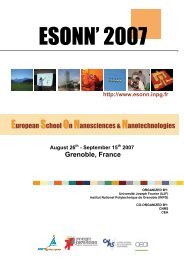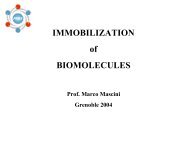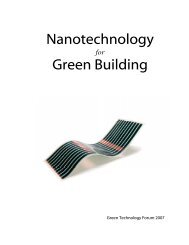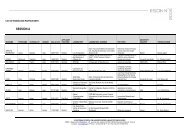BIOCHIPS : 1- Introduction to DNA microarray technology ... - esonn
BIOCHIPS : 1- Introduction to DNA microarray technology ... - esonn
BIOCHIPS : 1- Introduction to DNA microarray technology ... - esonn
You also want an ePaper? Increase the reach of your titles
YUMPU automatically turns print PDFs into web optimized ePapers that Google loves.
<strong>BIOCHIPS</strong> :1- <strong>Introduction</strong> <strong>to</strong> <strong>DNA</strong> <strong>microarray</strong> <strong>technology</strong> and application <strong>to</strong>comparative genomic hybridization2- <strong>Introduction</strong> <strong>to</strong> protein <strong>microarray</strong> <strong>technology</strong> and application <strong>to</strong>antigen-antibody interaction using SPRiF. Bruckert, M. WeidenhauptPhelma/LMGP Grenoble Institute of TechnologyCentre Interuniversitaire de MicroElectronique<strong>DNA</strong> <strong>microarray</strong>s<strong>DNA</strong> chips are high-density arrays of oligonucleotides or small <strong>DNA</strong> fragments(probes) immobilized on a surface. Hybridization of fluorescent-labeled target <strong>DNA</strong> <strong>to</strong>complementary probes on the surface can be visualized by fluorescence imaging.<strong>DNA</strong> chips are nowadays widely used <strong>to</strong> identify gene alleles, pathogen species and<strong>to</strong> study gene expression and eukaryote gene editing.This practical combines several well-employed technologies in the field ofmicro-and nano-technologies applied <strong>to</strong> biology. The lab work entails all steps ofstandard <strong>DNA</strong> <strong>microarray</strong> <strong>technology</strong>, from <strong>DNA</strong> probe spotting <strong>to</strong> comparative <strong>DNA</strong>hybridization analysis. Students will carry out hands-on experiments on organicmacromolecules covalent coupling on an inorganic substrate, <strong>DNA</strong> preparation andfluorescent labeling, hybridization and washings, fluorescence microscopy,quantitative image analysis.Left : MicroGrid Microarrayer ; Center : Genewave AmpliReader ; Right : Example of <strong>DNA</strong>array hybridized with two target <strong>DNA</strong> preparations labeled with green and red fluorophores.Protein <strong>microarray</strong>sPeptide <strong>microarray</strong>s can be used for high-throughput screening of binding partners incomplex biological fluids like blood, for example. In this practical we will use goldlayeredprism surfaces with defined arrays of polypyrrole-coupled peptides andSurface Plasmon Resonance imaging (SPRi) for studying antigenic peptide-antibodyinteractions. The SPRi signal reflects local mass changes at the surface of the prismand does not require previous labeling of the interacting antibodies. We willdemonstrate that the signal produced by peptide-antibody binding is highly specificand can be quantified.Left : SPRi-Lab+ from Horiba Jobin Yvon and gold-layered prisms (right)
The practical schedule is as following:Day 1 (8h) : <strong>DNA</strong> probe covalent grafting on silanized high-sensitivity reflectiveglass plates (AmpliSlides, Genewave). Probes will be spotted with a Microgrid<strong>microarray</strong>er (BioiRobotics). Purification of plasmid <strong>DNA</strong> from different strains ofbacteria. Insert amplification by Polymerase Chain Reaction and target <strong>DNA</strong> labelingwith AlexaFluor 546 or AlexaFluor 647. Hybridization with fluorescently labeledtarget <strong>DNA</strong>.Day 2 (4h): Comparative fluorescence analysis with a CCD-based fluorescencereader (AmpliReader, Genewave). Quantitative analysis of fluorescence signals.The specificity and reproducibility of the technique will be studied. The influence ofprobe-target mismatches on the strength of the hybridization signal will bedemonstrated.Day 2 (4h): Analysis of the interaction between antigenic peptides grafted on aSPR prism and a mixture of antibodies present in different sera. The interactionspecificity and quantity will be analyzed using SPR in the imaging mode. Cus<strong>to</strong>mizedprisms will be readily available and an SPRi-Lab+ system from Horiba Jobin Yvonwill be used.


